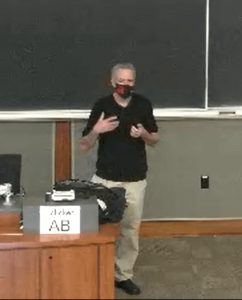
If you observed one of Brett Couch’s classes, you would notice that in addition to talking about course content, he also frequently explains the ‘why’ behind his teaching decisions, reveals secrets to success, and shares personal experiences.
This type of non-content talk directed to the entire class is known as Instructor Talk, and using it can help to set up a supportive learning environment for students. More information about Instructor Talk, including some of Brett’s Instructor Talk quotes, can be found here.
Below, Brett describes his motivation for using Instructor Talk, the impact this has had on his students and course, and what he’s learned along the way.
What is your motivation for using Instructor Talk in your classroom?
My motivation is trying to be less intimidating and more accessible to students. I want to create a classroom environment that is a community and where all students feel comfortable speaking up and asking questions. However, I’m an intense person and I tend to be intimidating when people first meet me. I want students to see me as supportive rather than the feared “Professor” that decides their destiny with a red pen on an exam, and using Instructor Talk is one way that I try to make myself more approachable and break down barriers for students to come and talk to me and ask questions in class or office hours. I also use Instructor Talk to let parts of my personality shine through so that students see me as a person.
Additionally, I want to help students do well in the course, so some of my Instructor Talk is meant to give them hints and tips for success. For example, I try to be explicit about when I think something is important and how I’ll be assessing them on it.
What impact has this had on students or the course?
I feel that it’s helped to create a more comfortable and collegial classroom environment that encourages interaction, discussion and learning. It also seems to help students see me as supportive rather than adversarial, and I find that it can make students more likely to come and talk with me after class or during office hours. For example, at the beginning of the term I asked students to introduce themselves on Piazza with the idea that it would help them to form groups (I also shared this purpose with them in class and encouraged them to connect with other students they had something in common with). After reviewing their introductions, I commented on some common themes during class, including that I noticed there were a lot of people from Oakville and Mississauga, which are parts of Ontario where I grew up and did my undergraduate degree. After class, several students came up to me to let me know that they were from those areas and I think that hearing me talk about this in class helped them feel a connection with me and made it more comfortable for them to come and talk with me.
What have you learned?
Sometimes students need to hear things several times before they get it, so I try to repeat myself whenever I can, such as repeatedly sharing recommended study strategies or explaining why I’m doing something or what I want students to get out of it. Even if I’ve already said it before, they may need to hear it again for it to sink in.
What advice would you give others about using Instructor Talk in their own classrooms?
Spend time getting to know your students, because the more you understand what is causing them to struggle, the better you can use Instructor Talk during class to mitigate the common issues that students experience. For example, I’ve realized through my conversations with students that many of them didn’t know what to do during office hours, so I’ve gotten better at being explicit about what my office hours are for and what students can do during them. I’ve also learned that many students struggle with knowing how to effectively study for the exams, so now I’m more forthcoming with recommendations for study strategies during class.
Is there anything else you’d like to share?
Using Instructor Talk is something that I normally do, but I actually hadn’t thought about it too much before. Now that I’m aware of what it is and how I want to use it, I can be more intentional about it.